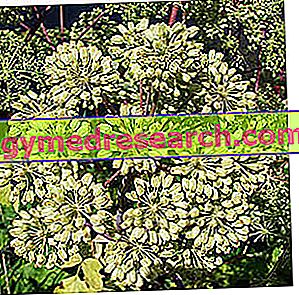By Dr. Rita Fabbri
The etymological meaning of Angelica is intuitive: it derives from the Greek, literally the announcer angel, hence the plant from the sky, hence the vulgar name Erba degli Angeli or Root of the Holy Spirit; archangelica because it was believed that the Archangel Raphael, the healing angel protector of doctors and pharmacists, had given men this plant, revealing its beneficial properties.

Perhaps for its religious significance, Angelica was widely used in the Middle Ages (1-2).
The herbalists of the sixteenth century advised to immerse the roots of Angelica in the vinegar and to breathe the vapors to avoid the contagion of the plague: according to tradition this remedy was indicated by the Archangel Raphael to a friar who prayed incessantly asking for divine help for the inhabitants of his country hit by the plague. Saint Hildegard described in the Herbora Sempliciorum - a handbook where the abbess mother listed the herbs grown in the convents from which many medicines were obtained - a remedy against fever based on Angelica. The Benedictine monks in their medicines and herbal liqueurs made extensive use of this plant, as in the famous Chartreuse liqueur which is prepared in two versions: yellow type with a sweet taste, and green, more alcoholic; in addition to the two traditional types there is also the white elixir de Chartreuse.
During the Renaissance, Angelica continued to be widely used and later became an excellent remedy for diphtheria and rabies, a stimulant of the lymphatic system, an adjuvant in the case of bronchitis and in the most serious forms of tuberculosis, a miraculous antidote against the poison of snakes and scorpions; it was also used in digestive disorders, in meteorism, in migraine of nervous origin, as a spasmolytic, as a diuretic and for external use against diseases of the oral cavity (3).
According to ancient authors, Angelica is the thaumaturgical plant par excellence: effective in female disorders, useful for making women fertile and able to ensure longevity: in 1759 an elderly gentleman died in Marseille at the age of one hundred and twenty thanks to a habit he had, at least it is said, of chewing the Angelica root every morning.
Angelica was also used as a remedy for male impotence and for this purpose the recipe for "tonic wine" is handed down: to leave to soak for a week, in a liter of red wine, 30 g of angelica root and 20 g of gentian root, and take a small glass of this mixture before each meal. According to others, however, to be an aphrodisiac would be the Angelica liqueur, which is obtained with the plant stems and brandy mixed with water and sugar.
Angelica is traditionally a lucky charm for those looking for a soul mate.
Angelica is the main essence of the famous "carmelite water", a herbal remedy widely used in the past: it is a distillate - in water of orange blossom and alcohol - of numerous spices, mainly angelic combined with lemon balm, coriander and Lemon peel; the recipe dates back to around 1500 and belongs to the French Carmelite nuns who prepared this mixture for the first time in their convent. The bath of the Carmelites, a famous bath against insomnia, contains the same ingredients used to make Carmelite Water: put it all in a gauze bag and hang it under the jet of water as it flows to fill the tank. Still of nuns the production of confetti with branches of Angelica, a highly sought after specialty in the past.
In Nordic countries, in periods of famine, Angelica was mixed with flour to make bread more nutritious.
The smell of Angelica is similar to that of licorice, very aromatic, so that its flowers are often surrounded by bees; the taste is sweet with an acrid and spicy aftertaste.
You can add a pinch of Angelica to give aroma to pipe tobacco and the leaves of this plant should always be present in the "pot-pourri".
Angelica is widely used in confectionery and in the liqueur industry.
The robust and fleshy root contains a juice that is used, after infusion in alcohol, to produce the homonymous liqueur, originating in the Basque Country.
After juniper berries, Angelica root is the main ingredient of gin. It is also used to flavor Anisette, Cointreau, Vermouth and Strega.
In the kitchen many parts of the plant are used: the raw or cooked leaves are used in the preparation of green salads, mixed vegetables, fish dishes, low-fat cheeses and cooked fruit; the hulled stem (the dark outer part is bitter) and finely chopped, is used to flavor spicy sauces, jams or preserves; the young twigs, harvested in April-June when they are more tender and green, are candied and used to garnish cakes, ice creams, puddings, jellies and fruit salads.
Angelica can be used as a tonic, digestive and relaxing infusion, which is obtained by pouring on 10 g of crushed root a liter of boiling water, leaving it to rest for 5-6 minutes before filtering; it is advisable to drink a cup of this herbal tea after the main meals.
Also excellent is the homemade liqueur obtained by macerating half a liter of pure alcohol with half a pound of freshly chopped Angelica root, along with three bitter almonds. During the next three weeks the contents of the bottle should be shaken several times a day. Subsequently, 250 grams of sugar are dissolved in half a liter of water, this syrup is boiled for five minutes and, after cooling, it is added to the Angelica infusion.
Angelica seed infusion is an excellent decongestant eye pack and can be used as a facial tonic; the essential oil, especially that obtained from the seeds, is used in the production of perfumes, soaps, creams and toothpastes.



